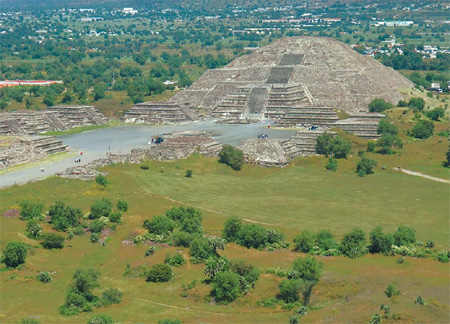
The Pyramid of the Moon stands at the northern end of the Avenue of the Dead at the site of Teotihuacan.
 |
|
The Pyramid of the Moon stands at the northern end of the Avenue of the Dead at the site of Teotihuacan. |
However, after my recent trip to the city, with a group of Chinese journalists, invited by the Mexico Tourism Board, I have a different image.
During our stay, none of us were the victims of crime and we didn't even encounter a quarrel on the streets.
We didn't see Mexico City's sprawling slums until we headed out of the city toward the pyramids of Teotihuacan, two days after arriving.
As to air pollution, well, we didn't feel it. In fact, I quite enjoyed the city's weather. It was cool in the morning and night and could be hot at noon. Although it was often cloudy, it was never hazy, like Beijing recently.
While the city has a population of 25 million it doesn't appear to be densely populated (from a Chinese point of view) as most of the buildings are low-rise. Also, it was not too crowded at the few tourist attractions we saw in the heart of Mexico City - the Plaza de la Constitucin, or Zocalo, as it is more commonly known.
We had a pleasant stroll around the plaza on a Sunday morning. It is like a market surrounded by Spanish colonial buildings, including the Metropolitan Cathedral and National Palace.
Conchero dancers remind many Mexicans of their ancestors, the Aztecs, with daily get-togethers in the plaza's northeastern corner. Here, they performed ceremonial dances to the rhythm of booming drums, dressed in feathered headdresses and conch shell anklets and bracelets.
Peddlers sold goods ranging from hammocks and wooden scarves, to home-made pearl cream and tiocoyo tortillas, made of green corn and served with tomato and green pepper sauce and cheese.
The National Palace is home not only to the offices of the president of Mexico and the Federal Treasury, but also dramatic murals by Diego Rivera (1886-1957), the world-famous Mexican painter and husband of Frida Kahlo, an influential painter known for her self-portraits.
The colorful murals on the main stairwell and the walls of the second floor of the palace around the central courtyard present the artist's view of Mexican civilization between 1521 and the 1910 revolution. They were painted between 1929 and 1935.
The splendid work is a feast of colors with vivid figures depicting The Epic of the Mexican People. From it, visitors can get an idea of the size and layout of Tenochtitlan, the Aztec empire's capital, which was in the downtown area near the Zocalco. In the mural you can see scenes such as Aztecs selling human sacrifices as sacred food in the market.
To a visitor from a different culture, the ancient Mayan and Aztec people's human sacrifices are weird and eye-catching.
At the impressive National Museum of Anthropology (Museo Nacional de Antropologia) a quick stroll was enough to become aware that there are many pyramids - the major place for rituals and human sacrifices - scattered around Mexico.
Many of the beautiful carved stone exhibits in the museum were once used for sacrificial rituals. For example, the famous Aztec Calendar Stone, or Stone of the Sun, was actually a large sacrificial altar and probably used to stage fights between warriors. Another example is a carved stone jaguar with a cavity on its back, which "functioned as a sacred recipient designed to contain the blood and hearts of captive warriors".
The next morning I found myself walking on the Avenue of the Dead (Avenida de los Muertos) at Teotihuacan, the site of Mexico's biggest ancient city, which had about 200,000 people at its peak. It was likely the capital of Mexico's biggest pre-Hispanic empire.
The stone-paved avenue is the axis of the site, which lies 50 km northeast of Mexico City. About 2 km to the north, it is flanked by the former palaces of Teotihuacan's elite, and other major structures, such as the Pyramid of the Sun. The Pyramid of the Moon stands at the northern end of the road.
The avenue is straight and wide and it is hard to believe that it was built between AD 250 and 600, together with most of the buildings in the ancient city. The later Aztecs believed that the great buildings lining it were vast tombs, built by giants for Teotihuacan's first ruler, hence the name.
But it is a good idea to take the less-trodden path and hike around in the overgrown land around the relics, full of short but stout Yucca trees and different kinds of flowering cactuses. Overshadowed by the Pyramid of the Sun, it is a lovely place, away from the hawkers and other tourists.
Climbing the 248 steps of the world's third largest pyramid - the Pyramid of the Sun - under scorching sun, is not easy, but it's worth it. Here you can see the awesome layout of the entire site.
After the hike and climb, lunch at a restaurant outside the site was tasty and memorable. Teotihuacan soup - chicken soup with pumpkin flowers and mushrooms, and avocado sauce with tortilla, was followed by a main course - beef, pork, chicken, fresh cheese and onions in a heated volcanic stone mortar.
Xochimilco is about 20 km south of downtown Mexico City and is an extended series of canals lined by plant nurseries and houses with lawns, which is a popular recreational destination for locals.
There we had our lunch while floating into a bizarre aquatic traffic jam on a flower-decorated and painted trajinera boat, while mariachi bands entertained, peddlers in small riverboats shuttled around and families enjoyed their lunches.
Listening to a mariachi band singing Guantanamera, with a beer in hand, it is easy to share one of the joys of living in this impressive city.
The author's tour in Mexico was arranged by Turismo Mayorista Premier and Best Day Travel.